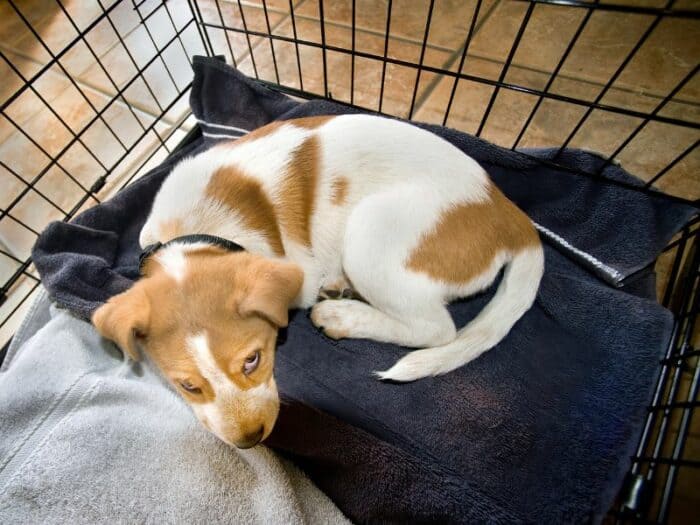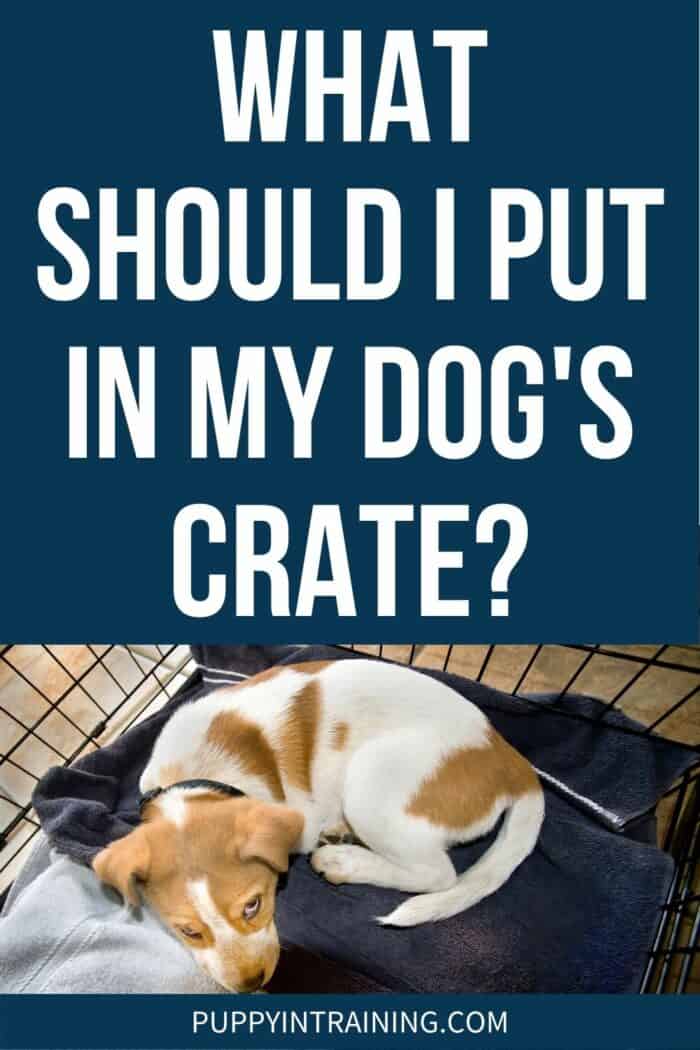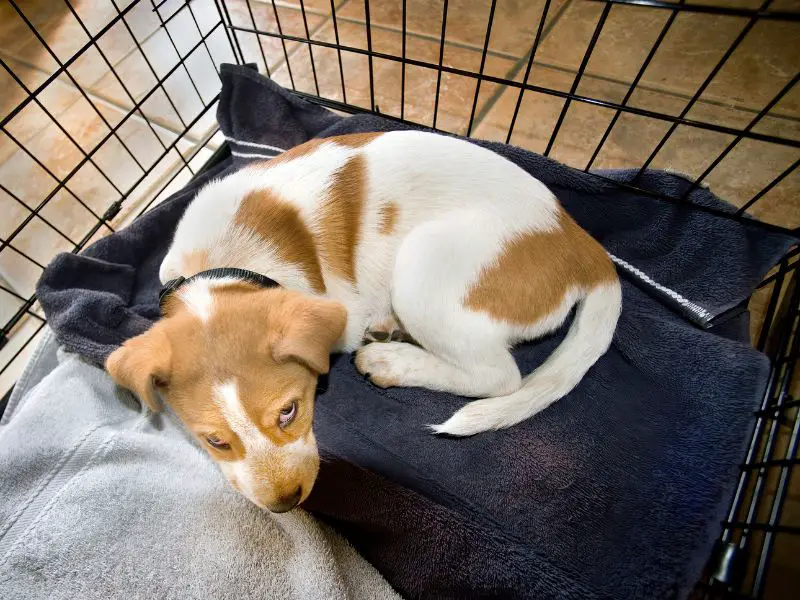This post may contain affiliate links. We may earn money or products from the companies mentioned in this post.
You want to do all that you can to ensure that your dog’s crate is a place he loves to be. But you ask yourself what you should put in your dog’s crate.
Your dog’s crate should be his sanctuary.
But it also needs to be a safe area. And anything that’s placed in or on the crate needs to be something that he can’t ingest.
In this article, I’ll describe what you should put in your dog’s crate.

And I’ll detail what should be placed there at the various stages of your dog’s life. Puppies, adults, and seniors have different needs and desires.
Where To Place the Crate
For young puppies or dogs just learning to enjoy a crate, I’ve found that it’s best to have a crate in your bedroom for when he sleeps overnight.
And you should also have a crate wherever your family hangs out, such as in the family room. You can move the same crate back and forth or have two separate crates.
Make sure that the location of the crate is not too warm or cold. So don’t place it directly near a heater vent, fireplace, radiator, or heater, or directly in the path of the sun’s rays.
How To Set Your Dog Up To Succeed in His Crate
To ensure that your dog loves being in his crate, introduce it properly.
Make sure that he’s had a sufficient amount of exercise before he enters his crate.
And don’t over-crate. Generally, a puppy of four months old can be crated for no more than five hours and an adult dog no more than eight hours.
What To Put in Your Dog’s Crate
A crate should be a den that your dog loves to remain in and be a safe haven.
But what’s safe depends on your dog’s age and likelihood to chew what’s contained therein.
It’s best to do a trial run even with the hopefully safe items in your dog’s crate while you’re present to determine whether he can or attempts to chew or ingest the items.
If you see that your pup is too destructive of those items, you can calmly release him from the crate and remove the dangerous items.
But be aware that your dog may behave differently when you’re present than he may when you’re away.
So you can set up a camera where you can watch him from another room to really test how he behaves when you’re out of sight.
Always err on the side of caution when placing something in your dog’s crate.
1. Food and water
Generally, it’s best not to put food or water in a dog’s crate.
If he’s eating and drinking while in the crate, chances are he’ll have to go to the bathroom. And he’ll have unavoidable accidents.
Usually the crate is used to help housetrain a puppy or dog. So placing food or water there will be counterproductive.
There are certain exceptions, however.
You may want to feed your dog in his crate, then take him out to potty immediately after.
This is sometimes done when a dog needs to learn to like his crate or if you have multiple dogs and want them to eat separately.
Another exception is when a dog has a physical condition requiring him to have food or water.
In such a case, your vet may tell you to give your dog access to water even in a crate. But, remember, that he’ll have to go to the bathroom.
So it’s best to have someone available to take him out to potty on a regular basis so that he doesn’t have an unavoidable accident in his crate.
A water dish will probably spill over and cause a mess and he won’t have any to drink.
Instead, you can train him to use a water bottle that’s hooked onto the outside of the crate if necessary.
2. Bedding
The type of bedding you should put in a crate depends on your dog’s stage of life and propensity to chew the bedding.
Young puppies generally want to chew everything in sight–especially when they’re teething.
By six weeks old, puppies have their baby teeth. Between three and six months old, puppies get their adult teeth.
Even the baby teeth can chew through bedding. And the adult teeth and stronger jaws can destroy even more materials.
Of course, puppies can ingest the materials–potentially leading to choking, an intestinal blockage, and high vet bills.
So regular blankets, towels, or soft fleece beds aren’t the best choices for puppies.
One type of bedding, VetBed, is especially durable even for puppies.
Although no type of bedding is indestructible, this is double-woven and extremely durable. And it’s recommended by vets and other pet professionals.
In addition, it’s hypoallergenic, anti-bacterial, machine washable, and even has drainage properties in the case of an accident.
The bed comes in various sizes to fit your pup’s crate.
But like anything you leave with your puppy in the crate, first observe him in the crate with the bed to be sure that he doesn’t chew it.
Be aware that when a puppy’s left alone he may be bored and try to chew.
That’s why it’s important to teach your puppy to love his crate and set him up to succeed in it. And to leave appropriate chew toys to occupy him and redirect his need to chew.
For an adult dog who doesn’t chew bedding, there are many choices available.
Some dogs like bolster-type beds where they can rest their heads on the outside like a pillow. And others like a thick, comfortable bed like a mattress.
You just want to make sure that it fits the whole crate and is large enough for your dog to lie down in and spread out comfortably.
For older, larger, or senior dogs who don’t chew beds, an orthopedic bed is a great choice.
The deep foam evenly distributes weight and alleviates stress on muscles and joints. This can be very soothing to older dogs with arthritis.
When I got an orthopedic bed for my golden retriever Riley, who’s around 70 pounds, I could see the joy on his face when he first laid down on it.
I could tell he was in dog-bed heaven with the new item in his crate.
For senior or other dogs who may be incontinent, you may want to leave a washable pad made for that purpose.
Of course if your dog can’t control his bladder, you should consult your vet regarding his health and any treatments he may require.
And you may need to confine him to an exercise pen or safe room with a potty pad that you train him to use in one area and a sleep/play area in another section.
Any bedding left in a crate should be comfortable and safe with no accessible zippers, plastic edges, or other pieces that can be alluring to your dog and chewed off.
If you discover that your dog chews any bedding at all, you should leave him in the crate without any until he’s old enough or settled enough in his crate to not chew it.
Of course you should first test him while you’re present to be sure that he won’t chew any bedding while in a crate. Always take a trial run to be sure your dog’s safe.
If he chews the bedding because he’s stressed in the crate, get professional help regarding his anxiety and how to re-introduce the crate or even use an alternate confinement method such as an exercise pen or a safe, puppy-proofed room.
3. Toys
Any toy that’s left in your dog’s crate should be sturdy. Leave two or three safe toys with your pup.
Of course, no toy is indestructible. But some toys are close.
Soft fleece or cloth-type toys shouldn’t be left alone with a puppy in his crate.
You don’t want to have the likelihood of your beloved pup choking or having an intestinal blockage.
But there are options that can be left if you first observe that your dog won’t–and can’t–chew through them. Some can be stuffed and frozen to add interest.
It’s important to give your dog something to do in his crate for many reasons. Enrichment items are necessary for a pup’s well-being.
Safe chew and activity toys:
- Keep your puppy busy and from being bored
- Teach your dog to chew safe items rather than destroying unsafe ones
- Expand your dog’s mind
- Help your pup love his crate, especially if he’s given the special items only when he’s in his crate
- Help him de-stress in his crate, as repetitive licking helps calm and soothe your dog because of the release of endorphins
Some potentially safe toys include:
- Large Nylabones. Always make sure to go up a size so that the toy can’t wedge in your dog’s throat or mouth. And don’t leave this toy alone with your dog if he’s an obsessive chewer who might ingest the toy while you’re gone.
- Extreme Basic Kong. This is a great overall toy that can be filled with yummy fillings like mashed pate dog food then frozen so that it takes more time to occupy your pup.
- Goughnuts. According to the manufacturer and many customers, these toys are virtually indestructible.
- Toppls. These are great toys that can be stuffed and frozen and take a long time for a dog to lick out the delectable filling.
I fill my dogs’ Toppls with a mixture of plain canned pumpkin, sweet potato baby food, and plain zero-fat Greek yogurt.
My dogs go crazy when it’s time for them to get their Toppls.
But Toppls are not chew toys and are really meant to have the filling licked out. So for moderate or heavy chewers, they shouldn’t be placed in their crate.
With an adult or senior dog, you may be able to leave softer cloth toys as long as he won’t chew them.
Of course, if there’s any doubt, err on the side of caution and don’t place them in a crate.
4. Items with Your Scent
Generally you shouldn’t leave items with your scent such as a shirt in a crate. This is true of any puppy or dog who’s likely to chew on cloth.
However, in very few specific cases, such as an adult or senior dog who’s beyond the chewing phase, an item with your scent can help him adjust to being in the crate.
5. Nighttime Special Items
For young puppies, there are items that can help them adjust being away from their mother and littermates.
One is the Calmeroos Puppy, which has a heartbeat simulator and heat pack that mimics a furry companion.
The outer cover is made of a plush material designed to resemble a puppy. This can help a pup adjust to being alone in his crate.
Caveat: if your puppy is over three months old or if any age pup is destructive and a chewer, don’t leave this in his crate unsupervised even if the crate’s placed in your bedroom at night.
After all, you have to sleep too and can’t observe him all night long.
6. Adaptil
If you have a dog or puppy who’s just learning to love his crate, you can spray his bedding with Adaptil.
This vet-recommended product mimics a mother dog’s natural nursing pheromones. It helps many dogs be calm and relaxed.
7. Crate Cover
Even though this is not technically in your dog’s crate, it’s important to consider whether you should cover his crate.
Generally, you shouldn’t place a cover over the crate that’s not specifically made for the crate.
Towels, sheets, and blankets can be pulled into the crate too easily and ingested by your pup. So, before you use them, make sure that your dog leaves them alone–outside the crate.
Some dogs love the den-like, secure feeling when their crate is covered. This is often true at night with some canines.
But others like to see out of their crate so that they can see what’s going on around them. This is often true when the crate is located in a central place such as a family room.
Always make sure that any crate cover allows for proper ventilation.
What NOT To Do: Don’t Try This at Home
There are some things that should never be placed in a crate in my opinion. I’ve been a trainer and behavior specialist for many years and always believe in erring on the side of caution.
In addition to being careful regarding the items stated above, there are some items that should never be placed with a dog alone in his crate.
1. Bones or chews that can splinter or break apart
Anything that can break apart or potentially break a dog’s tooth, pose a choking hazard, or cause an intestinal blockage shouldn’t be left alone with a dog.
2. Cloth items
With the exceptions stated above regarding dogs who don’t chew cloth items including soft toys or bedding, material items shouldn’t be placed in a crate.
3. Collars
Collars shouldn’t be left on dogs while in a crate.
There’s always a chance that the collar, tag, clip, buckle, or hooks on the collar can catch on the wires of the crate or kennel.
If any catch, of course your dog can choke with devastating results.
4. Potty pads
Potty pads usually have an attractant scent that encourages dogs to go to the bathroom on them.
The crate uses a dog’s natural instinct to not go to the bathroom on himself.
So placing a pad in the crate defeats the purpose of the crate being used to house train a dog.
Also, a puppy may chew and ingest the potty pad.
5. Items that use chemicals or electricity
Heating pads and similar items shouldn’t be placed in a crate with any dog.
Even if you have a senior dog with joint problems where heat might be soothing, there are other, safer options such as beds that radiate his own heat back to your dog.
If your dog requires such devices, it’s best to talk with your vet about what other additional treatments can help him be comfortable.
Also be sure not to place the crate near any electrical cords or unsafe items that your pup may pull into his crate.
FAQs
Should I place a bed in my dog’s crate? It depends. If your dog’s going to chew a bed, you may not be able to until he matures and doesn’t chew such items.
Should I leave water and food in my dog’s crate?
Generally no. Such items will cause a dog to have to go to the bathroom.
If your vet determines that there’s a medical reason to leave them, make sure that your dog is taken out to potty on a schedule that meets his needs.
Can I place enrichment toys in my dog’s crate?
It depends. The toy has to be virtually indestructible. Some rubber toys like the Extreme Kong are alright with all but the strongest chewers.
Generally, enrichment toys with plastic or cloth parts are dangerous when left alone with a crated dog because they can be ingested, potentially causing a dog to choke or leading to an intestinal blockage.
Conclusion
It’s important for your dog to love his crate. It’s a great management tool.
So you should put safe items in there to make the crate a comfortable, soothing, special place.
What you put in the crate depends on whether your dog is likely to chew the item. At different life stages, you may want to place different items in the crate to satisfy your dog’s needs.
What have you placed in your dog’s crate?
Have the items been successfully incorporated into your crating program?
Please tell us about it in the comments section below.
Save To Pinterest

Top Picks For Our Puppies
- BEST PUPPY TOY
We Like: Calmeroos Puppy Toy w/ Heartbeat and Heat Packs – Perfect for new puppies. Helps ease anxiety in their new home. - BEST DOG CHEW
We Like: Bones & Chews Bully Sticks – All of our puppies love to bite, nip, and chew. We love using Bully Sticks to help divert these unwanted behaviors. - BEST DOG TREATS
We Like: Crazy Dog Train-Me Treats – We use these as our high-value treats for our guide dog puppies. - BEST FRESH DOG FOOD
We Like: The Farmer’s Dog – A couple months ago we started feeding Raven fresh dog food and she loves it! Get 50% off your first order of The Farmer’s Dog.
Check out more of our favorites on our New Puppy Checklist.
